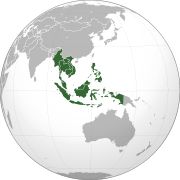Yang Yechi In Southeast Asia: A Fruitful Visit? – Analysis
By IPCS
By Teshu Singh
The Chinese foreign Minister Yang Yechi visited three Southeast Asia countries – Indonesia, Malaysia and Brunei during 9 -13 August 2012. The visit came right after two specific developments – the failure of the ASEAN to come up with a communiqué and the Chinese unilateral move of upgrading the Sansha Island from county level to prefecture level.
The South China Sea (SCS) is a disputed region between Brunei, Malaysia, Indonesia, Vietnam, the Philippines and China. Intriguingly, of these five major claimants of the dispute, Mr Yang visited three of them. Why particularly these three countries and what has been discussed during the dialogue? Will a high level dialogue reduce the tension in the region?
Significance of Indonesia, Brunei and Malaysia

Indonesia’s strategic significance can be understood from the fact that it played ‘shuttle diplomacy’ between the countries during the present ASEAN meeting. Indonesian foreign minister came out with a ‘common position’ of the ASEAN members to the declaration of a code of conduct and UNCLOS. Regardless of the fact that it has overlapping territorial claims with China and Taiwan over the Natuna gas fields, it is one of the proactive countries in Southeast Asia which has taken initiatives towards a binding code of conduct for the SCS. Earlier Indonesia held various discussions at the Track-II levels. It has hosted Canadian International Development Agency (CIDA) and funded six annual quasi diplomatic workshops on the SCS. There is increasing tension in the region between Vietnam-China, Philippines-China; Indonesia can take initiatives to resolve the issue – Indonesian Prime Minister added that a common approach to resolving the issue was needed, “ otherwise, the risk of further tension are very much ahead of us.”
Brunei is rich in oil and gas (it is the third largest producer of oil in Southeast Asia and the fourth largest exporter of Liquefied Natural gas in the Asia Pacific) thus it is no surprise that energy resources have become the backbone of Sino-Brunei relations. The year 2011 marked the 20th year of their diplomatic ties. Brunei will take over as the next chair of ASEAN, thus Beijing is forging closer ties so that it continues playing positive role in upholding China-ASEAN cooperation. The only exception is an overlapping territorial claim over Louisa Reef in the disputed Spratly Island group which is a cause of tension for both.
China became Malaysia’s largest trading partner in 2010 and it has been the largest ASEAN trading partner since 2008.Trade volume between the two nations exceeded US$ 9 million in 2011. Economic relations can help in reducing tension in the future. Further the year 2012 is proposed to be ‘Malaysia-China Friendship Year’ to commemorate the 40th anniversary of the establishment of diplomatic relations between Malaysia and China. Thus Beijing looks further to develop its relations by continuing their high level exchanges, broadening their financial cooperation and deepening cultural exchanges with Malaysia.
Implications of the Visit
Southeast Asians stand divided today vis-a-vis China. While the Philippines and Vietnam are critical of Beijing’s actions in the region Cambodia has closer relations with Beijing. The main thrust of the visit was to discuss the SCS issue and foster stronger bilateral relations with these countries. However, there were no major agreements signed during the visit. The only noticeable development of this visit was the Malaysian standpoint where it urged the Southeast Asian countries to settle their overlapping claims in the SCS before bringing them up with Beijing.
It is evident that Beijing does not want its broader ties with the region to be dominated by the SCS issue hence it is pushing its bilateral relations. Nevertheless, none of the three countries believe in a bilateral solution to the dispute. They are of the firm opinion that the dispute is multilateral in nature, and therefore requires a multilateral solution.
At the same time, such high level visits are becoming a trend in Chinese Foreign Policy to push forward its good neighbourly policy and to ensure that its ‘charm offensive’ does not decline in the region. But this does not suggest that Beijing will be more flexible in its claims on the disputed area. In August 2011, Xinhua reiterated separately by warning Japan’s Prime Minister and Philippines President that good relations cannot be based only on strong economic ties, but require “commitment to a proper settlement of the maritime disputes in the South China Sea.”
Tensions are building up in the region. Seeing the economic vitality of the region both the US and China are deeply interested in the region. The US has commented that China should not use bilateral talks to attempt to ‘divide and conquer’ nations of the Southeast Asia. Many US companies are shifting their operations from China to Southeast Asia, a survey by the American Chamber of Commerce in Singapore showed that 21 per cent of the US companies planned to reduce reliance on China and move their business to Southeast Asia over next two years. A visit of this level, therefore, is just part of the evolving Sino-US great game in the Southeast Asia.
Teshu Singh
Research Officer, CRP, IPCS
email: [email protected]
